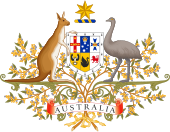Draft:Seas and Submerged Lands
| An editor has marked this as a promising draft and requests that, should it go unedited for six months, G13 deletion be postponed, either by making a dummy/minor edit to the page, or by improving and submitting it for review. Last edited by ITBF (talk | contribs) 3 months ago. (Update) |
| Seas and Submerged Lands Act 1973 | |
|---|---|
 | |
| Parliament of Australia | |
| |
| Citation | No. 161, 1973 |
| Assented to | 4 December 1973 |
| Repealed | 4 December 1973 |
| Introduced by | Whitlam Government |
| Status: In force | |
The Seas and Submerged Lands Act 1973 is an act of the Parliament of Australia that proclaims the sovereignty of the Australian federal government over the country's territorial waters and related seabeds.
The passage of the act was controversial. It was introduced in 1969 by the Gorton government, with the strong backing of Prime Minister John Gorton. However, elements within Gorton's Liberal Party viewed the legislation as an attack on states' rights. Near-identical legislation was ultimately passed by the Whitlam government in 1973.
Background
[edit]The Holt government's Petroleum (Submerged Lands) Act 1967 split sovereignty over offshore petroleum reserves between the state and federal governments, giving legal force to an informal agreement made in 1964. John Gorton succeeded Harold Holt as prime minister in January 1968 and began to take an interest in the matter of territorial waters. In February 1969, federal cabinet decided to assert non-petroleum mineral rights beyond the existing limit of 3 nautical miles (5.6 km).[1] National development minister David Fairbairn informed state ministers of the federal government's intentions the following month, promising further discussion over the exact terms. However, Gorton preferred to legislate unilaterally.[2] In January 1970, cabinet agreed to legislate for exclusive federal jurisdiction from the low-water mark to the edge of the continental shelf. It further resolved that there was no need to inform the states of the intended legislation in advance.[1]
Provisions
[edit]Original act
[edit]Amendments
[edit]Passage
[edit]Territorial Sea and Continental Shelf Bill
[edit]Seas and Submerged Lands Bill
[edit]Legal history
[edit]High Court challenge
[edit]In June 1974, three states – New South Wales, Queensland and Western Australia – challenged the constitutionality of the act in the High Court.[3] Their arguments were eventually heard by the High Court in 1975 as New South Wales v Commonwealth (more commonly called the "Seas and Submerged Lands Case"). The court ruled unanimously that the act was a valid exercise of the federal government's external affairs power.
Other cases
[edit]Prior to the establishment of the OCS in 1979, the High Court invalidated several portions of state legislation that purported to extend jurisdiction outside of territorial limits, with the federal legislation taking precedence under section 109 of the constitution. In Robinson v Western Australian Museum (1977), the court voided provisions that purported to give the Western Australian Museum possession of shipwrecks in coastal waters. The museum had claimed ownership of the wreck of the Vergulde Draeck, a 17th-century Dutch ship located less than 3 miles (4.8 km) offshore, despite its discovery by private individuals. State jurisdiction over certain shipwrecks was later restored by the OCS, though without retrospective effect. In Rapton v South Australia (1977), the court invalidated a state government's seizure of a unlicensed prawn fisherman's catch, as the .[4]
See also
[edit]References
[edit]- ^ a b Hancock 2002, p. 272.
- ^ Hancock 2002, p. 273.
- ^ "Three states now oppose offshore act". Canberra Times. 26 June 1974.
- ^ White 2011a, p. 8.
Sources
[edit]- Hancock, Ian (2002). John Gorton: He Did It His Way. Hodder. ISBN 0-7336-1439-6.
- Harders, C. W. (1977). "Commonwealth and state jurisdiction over off-shore areas" (PDF). Australian Mining and Petroleum Law Journal. 1 (1).
- White, Michael (2011a). "Australia's offshore legal jurisdiction: part 1 – history & development" (PDF). Australian and New Zealand Maritime Law Journal. 25.
- White, Michael (2011b). "Australia's offshore legal jurisdiction: part 2 – current situation" (PDF). Australian and New Zealand Maritime Law Journal. 25.
- summary (probably not able to be referenced): https://www.ag.gov.au/Internationalrelations/InternationalLaw/Documents/offshore-constitutional-settlement-a-milestone-in-cooperative-federalism-pages-1-10%20ocr.pdf
- 1970 bill: "Territorial Sea and Continental Shelf Bill"
- states respond: https://trove.nla.gov.au/newspaper/article/110321958
- OCS: https://www.ag.gov.au/Internationalrelations/InternationalLaw/Pages/TheOffshoreConstitutionalSettlement.aspx
- https://ro.uow.edu.au/cgi/viewcontent.cgi?referer=https://www.google.com.au/&httpsredir=1&article=1509&context=lhapapers
- external affairs power: https://www.aph.gov.au/parliamentary_business/committees/senate/legal_and_constitutional_affairs/completed_inquiries/pre1996/treaty/report/c05
- second bill respones: https://trove.nla.gov.au/newspaper/article/110785211
- court case: https://trove.nla.gov.au/newspaper/article/102193266
Category:1973 in Australian law Category:Australian constitutional law
